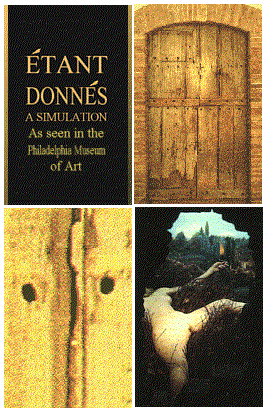This page contains the Cool Image of the Day for 9-10 May 1998
Here are the Nine Malic Moulds,
Here are the Nine Malic Moulds,
part of Dew
Harrison's project: Deconstructing Duchamp.
The Large Glass
by

(1887-1968):
DUCHAMP QUOTES [Some are paraphrased.]:
I believe that the artist doesn't know what he does. I attach even more importance to the spectator than to the artist.
REPLY TO QUESTION - WHAT SATISFIES YOU MOST?
Basically, that I've never worked for a living.
In 1905, I worked at a printer's in Rouen, passed an examination to be classified as an art worker, served one year in the military as a student officer. Then I was discharged. So I became completely exempt from military service.
I left Montmartre in 1908 to go live in Neuilly until 1913.
Only the "Large Glass" interested me, ... I wanted to be free of any material obligation, so I began a career as a librarian, which was a sort of excuse for not being obliged to show up socially. ... I knew very well that I would never be able to pass the examination at the school, but I went there as a sort of grip on an intellectual position. At the same time, I was doing my calculations for the "Large Glass".
The ideas in the Large Glass are more important than the actual realization.
The "Large Glass" constitutes a rehabilitation of perspective. For me, it's a mathematical, scientific perspective, based on calculations and on dimensions.
Everything was becoming conceptual, that is, it depended on things other than the retina.
What we were interested in at the time was the fourth dimension. Simply, I thought of the idea of a projection, of an invisible fourth dimension, something you couldn't see with your eyes.
"The Bride" in the "Large Glass" was based on this, as if it were the projection of a four-dimensional object. I called "The Bride" a "delay in glass."
A tactile sensation which envelopes every side of an object approaches a tactile sensation of four dimensions. Consequently the act of love as tactile sublimation could be felt as a physical interpretation of the 4th dimension.
The use of glass has no significance other than to protect my colors, giving maximum effectiveness to the rigidity of perspective. It also took away any idea of "the hand" of materials.
The Large Glass is a lot better with the breaks, a hundred times better. It's the destiny of things.
For me the number three is important: one is unity, two is double, duality, and three is the rest.
My "Three Standard Stoppages" is produced by three separate experiments, and the form of each one is slightly different.
At first I thought of eight Malic Moulds and I thought, that's not a multiple of three. It didn't go with my idea of three. I added one, which made nine.
The mold side is invisible. I always avoided doing something tangible, but with a mold it doesn't matter, because it's the inside I didn't want to show.
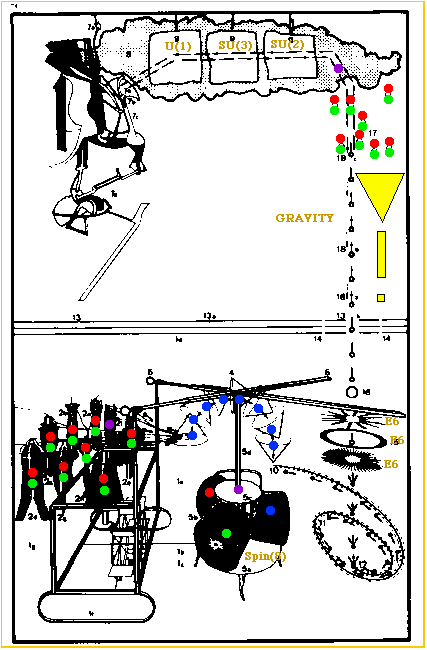
The image above is a key to The Large Glass.
The beginnings of The Large Glass go back to Duchamp's visit to Munich in July and August of 1912.
Duchamp's apartment was near the university at which Sommerfeld taught. Sommerfeld was later advisor to Heisenberg and Stueckelberg. I do not know whether Duchamp and Sommerfeld ever met.
Octavio Paz wrote: "It is above all the rigorous unity of Marcel Duchamp's work that surprises anyone reviewing it in its entirety. ... He was fascinated by a four-dimensional object and the shadows it throws, those shadows we call realities. The object is an Idea, but the Idea is resolved at last [in the Philadelphia assemblage] into a naked girl, a presence."
Here is a color gif (185k) of The Large Glass.
Here is my interpretation of The Large Glass, also called La Mariee Mise A Nu Par Ses Celibataires, Meme, which interpretation draws heavily on the D4-D5-E6 physics model and on my view of Life, the Universe, and Everything:
The glass is as transparent as the transparent Clear Light, between the Dark Imminence and the colorful 4-phase Bardo of Luminous Dharmata.
The circular water wheel has 8 paddles. The 8 paddles are the octonions, and the circle represents their multiplication.
The octonion water wheel is within a 3-dimensional cube with runners. The runners indicate that the 3-dimensional cube should move, and such motion should define a 4-dimensional hypercube. Choosing the black squares of a chessboard tiling of 4-dimensional space by hypercubes gives a 24-cell tiling of 4-dimensional space. A 24-cell is essentially a hypercube with a hyper-pyramid added to each of its 8 faces. Duchamp's Small Glass, To Be Looked at (from the other side of the Glass) with One Eye, Close to, for Almost an Hour shows a hyper-pyramid to be placed on each face of the hyper-cube formed by the 3-dimensional cube with runners in The Large Glass.
There were originally to be 8 bachelors, each with 3 capillary stoppages, for a total of 24 sources of particles.
Duchamp changed his mind, adding a 9th bachelor and connecting the 9 bachelors to 9 stoppages (one each).
The 8 original bachelors are (first generation) fermion particles (red dots) and antiparticles (green dots). The 9th bachelor is the scalar particle (purple dot). The stoppages are each 1 meter, so that everything arrives in phase.
The stoppages lead to 8-dimensional spacetime, represented by 7 spacelike lightcones (blue dots). The 8th dimension, time, is not represented by a lightcone, but has a blue dot.
For an octonionic coordinate basis (1,i,j,k,e,ie,je,ke), the lightcones have the following 2-dimensional spaces:
(i,j), (j,k), (k,i), (e,(ie+je+ke)), (ie,je), (je,ke), (ke,ie)
In The Large Glass, Duchamp has tilted the lightcones relative to one another.
Tilting of lightcones can occur in the D4-D5-E6 physics model from virtual 4-pair gravitons, which are effectively Planck-mass black holes. Such tilted lightcone spacetimes are only a very small proportion of any quantum superposition describing physical spacetime. Roger Penrose in his book Shadows of the Mind (Oxford (1994)) describes a quantum gravity theory of David Deutsch in which only a very small fraction of the spacetime geometries in a superposition contain closed timelike loops. Even a very small number of closed timelike loops may permit classically non-computable operations to be performed by a human-brain quantum computer based on microtubule structure, which could feed on its own output, running around closed timelike loops.
The semicircle on which Duchamp's lightcones lie corresponds to a timelike axis in spacetime that is the RP1 of the 8-dimensional spacetime RP1xS7 and also the RP1 of the reduced 4-dimensional spacetime RP1xS3.
There may be a non-trivial correlation among the lightcones in our universe with respect to its fundamental underlying 4-dimensional Feynman checkerboard structure, due to primordial Planck-mass black holes.
The spacetime of the lightcones and the fermions and scalar are connected to the chocolate grinder.
The chocolate grinder receives octonionic structure from the water wheel.
Mitchell Whitelaw has a musical composition (in Macintosh Finale format) based on the chocolate grinder on his home page.
The chassis of the chocolate grinder represents the 28 infinitesimal generator gauge bosons of the adjoint representation of Spin(8).
The 3 rollers of the chocolate grinder represent the 8-dimensional spacetime (blue dot), the 8 (first generation) fermion particles (red dot), and the 8 (first generation) fermion antiparticles (green dot).
The necktie of the chocolate grinder represents the scalar particle.
Together, the chassis and 3 rollers of the chocolate grinder form the Dynkin diagram of Spin(8):
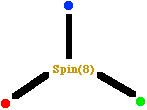
The chocolate grinder and the hypercube are connected to a pair of scissors, which cut off 4 of the 8 dimensions of spacetime, leaving a quaternionic 4-dimensional spacetime with basis (1,i,j,k) and lightcones:
(i,j), (j,k), (k,i)
Duchamp's 4 Oct 54 statement:
"For me there is something other than yes, no, and indifferent - it is for example the absence of investigations of this kind."
showed his understanding of the fundamental basis of quantum theory, with "indifferent" being his term for "superposition", and "investigations" being his term for "experimental measurements".
A path integral sum over histories quantum theory is given by the butterfly pump, which pumps out amplitudes for all possible paths, the sum of which is represented by a Cornu spiral (see Funktionentafeln, Jahnke and Emde, 4th Ed. Dover (1945)) sum of amplitudes:
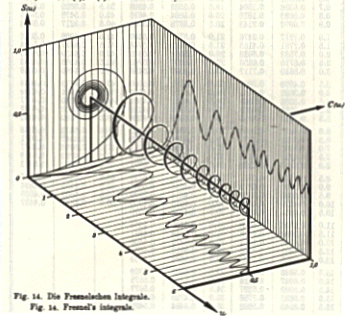
The Cornu spiral is the projection on the (S,C) plane in (S,C,u) space of the Fresnel integral curve in (S,C,u) space. The 3-dimensional Fresnel integral curve resembles Duchamp's Rotary Glass Plates (1920).
The 3 oculist witnesses correspond to the Lie algebra E6, and also to E6, E7, and E8.
E6 is 78-dimensional, like the 78 cards of the Tarot.
E6 has a 27-dimensional representation, related to the Tai Hsuan Ching.
The top oculist witness has 12 radial groups of rays (each of which is a made up of 3 rays). The 12 rays lead to 12 of the root vectors of E6.
Further, the 12 rays correspond to the 12 lines of the Schlafli double-six:
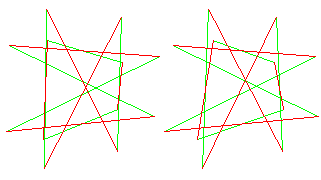
All 36 of the rays correspond to the fact that there are 36 double-sixes in the 27 lines on a general cubic surface:
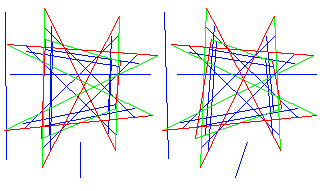
The symmetry group of the 27 line configuration is the same as the symmetry group of the 6-dimensional polytope 2_21 with 27 vertices and 27+72 faces, that is, the Weyl group of E6 of order 72x6! = 51,840 (see Coxeter, Math. Z. 200 (1988) 3-45) and may be related to the 27-dimensional Jordan algebra J3(O) and a 27-dimensional M-theory geometry of MacroSpace.
The middle oculist witness has 6 circles. They correspond to the 6-torus, the maximal torus of the E6 Cartan subalgebra.
The bottom oculist witness has 60 radial rays. Together with the 12 groups of rays of the top oculist witness, they correspond to the 72 root vectors of E6.
15 of the 60 correspond to the 15 bivectors of Spin(6).
The other 45 of the 60 correspond to the infinitesimal generators of the Spin(10) subalgebra of E6.
All 6+6+15+45=72 can be represented by the 27 lines and 45 points of the configuration dual to the 27-line 135-point configuration of lines on a cubic surface.
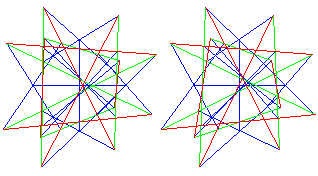
The Weyl group of E6 is the invariance group of the Gem of the Modular Universe by Bruce Hunt. He has also written a nice paper on Hyperbolic Planes, and a beautiful book:
The Geometry of some special Arithmetic Quotients, Lecture Notes in Mathematics 1637 (Springer 1996), which makes reference to pictures at the web site http://www.mathematik.uni-kl.de/~wwwagag/Galerie.html.
The magnifying lens corresponds to the increase in scale from the fundamental Planck-length lattice to the larger scales that we can observe by experiment today.
The region of the boxing match corresponds to the reduction of the original Spin(8) gauge group that existed prior to dimensional reduction of spacetime to gravity and SU(2)xSU(3)xU(1) that we now observe.
The region of the Wilson-Lincoln effect corresponds to dimensional reduction from 8-dimensional spacetime to 4-dimensional spacetime (Wilson) plus a 4-dimensional internal symmetry space (Lincoln), which in turn produces the Higgs mechanism that gives mass to the SU(2) weak bosons and to the Dirac fermions, with one massive residual Higgs scalar.
In the region of gravity:
the weight (representing a single point) corresponds to the single octonion O representing first generation fermions;
the rod (representing its 2 end-points) corresponds to the octonion pair OxO representing second generation fermions; and
the trivet (representing its 3 corners) corresponds to the octonion triple OxOxO representing third generation fermions.
The 8 shots in the 4-dimensional spacetime with gravity represent the 8 types of fermion particles (red dots) or antiparticles (green dots).
The 9th shot, in the Milky Way, represents the Higgs scalar.
The randomness of the 9 shots is due to quantum fluctuations.
The Milky Way separates the region of the bachelors from the region of the bride, just as in the Chinese legend of the Seamstress (Vega) and the Cowboy (Altair).
The 3 pistons in the Milky Way represent the 3 forces of the standard model: the SU(2) weak force; the SU(3) color force; and U(1) electromagnetism.
The bride represents the spirit world of massless unconfined gauge bosons:
photons (of the light of the filaments in the upper left part of the bride); and
gravitons (of the gravity related to the pendulum-like suspension from the mortice joint of the center right part of the bride).
Those parts of the bride are interconnected and interact to influence the wasp, which extends (through its weathervane, which represents a light-like world-tube) to the horizon to influence the material world of the bachelors.
Duchamp's 4 Oct 54 statement:
"... the Bride or the Pendu femelle is a 'projection' comparable to the projection of an 'imaginary entity' in 4 dimensions in our world of 3 dimensions (and even in the case of flat glass to a reprojection of these three dimensions on a surface of 2 dimensions)."
shows that Duchamp thought of the Bride in The Large Glass as a being made of photons or gravitons, i.e., made up of 4-dimensional lightlike worldlines.
If The Large Glass were to be combined with its mirror-image, then the result would be this (348k).
After 1923, Duchamp quit working on The Large Glass and begain to play chess intensively. He did not care about competition, but played chess to design or construct something beautiful. The 64 squares of the chessboard can be used to represent:
the 8x8 matrix representation of the Spin(8) Lie algebra;
each of the two half-spinor parts of the even subalgebra of the Spin(8) Clifford algebra; and
the 64-dimensional Clifford algebra of Spin(6) = SU(4).

In the Paris exhibition Le Surrrealisme en 1947 , Duchamp displayed Le Rayon Vert -
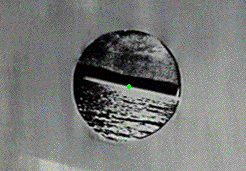
- a view through a ship's porthole of the green flash of the setting sun. Le Rayon Vert may have been based on Jules Verne's 1882 novel Le Rayon-Vert. Verne's novel was updated in Eric Rohmer's 1986 movie Rayon Vert, which for reasons difficult for me to comprehend was retitled in English as Summer. I have wondered whether Luu Dongbin was looking at an Eastern sunrise version of Le Rayon Vert during a mountain-top meditation.
Duchamp's Le Rayon Vert disappeared after the 1947 exhibition closed, and Duchamp did not reproduce it.
Duchamp worked in secret from 1946 to 1966 on
Etant Donnes. Etant Donnes must be viewed through a peep-hole in the foreground door. The view is further directed by a hole in the midground brick wall. The background contains a landscape and waterfall.
Between the midground and background is a diorama, perhaps related to the Heilige Kuemmernis that Duchamp may have encountered in his visit to Munich in 1912, and the story of a daughter of a mythical king. Tim K did the animated gif of Etant Donnes on his Duchamp pages, showing what you would see as you approached the door and looked through the peep-hole, with the midground brick wall framing the diorama and background.
1960s: Etant Donnes restricts the view of the spectator in two planes: the foreground hole in the door and the midground hole in the brick wall.
1940s: Le Rayon Vert restricts the view of the spectator in one plane - of a ship's porthole through which the spectator sees the green flash of the setting sun.
1920s: The Large Glass does not restrict the view of the spectator at all - the spectator can look through it from any side or angle.
The Large Glass is at Philadelphia Museum of Art. Since Le Rayon Vert has disappeared, it is not there.
Etant Donnes was not shown until after Duchamp's death in 1968. It is now in the Philadelphia Museum of Art. If you would like to see jpg images of the diorama and background, and of the foreground door, in Etant Donnes, you can go to the texas.net Museum of Art and go to its ftp site, then go to Duchamp, and go to the images. It is a good art site with interesting features and many images.
Sources and References:
Marcel Duchamp, Moure, Rizzoli (1988);
The Definitively Unfinished Marcel Duchamp, de Duve (ed), MIT Press (1991);
Marcel Duchamp, Hulten (ed), MIT Press (1993); and
Dialogues with Marcel Duchamp, 1966 interview with Pierre Cabanne, Plenum (Da Capo) (1971, 1987) (During the interview, even when asked about giving up art, Duchamp does not mention Etant Donnes (1946-1966).)
The Complete Works of Marcel Duchamp, by Arturo Schwarz, Third Revised and Expanded Edtion, published in 1997 by Delano Greenidge Editions, New York.
Marcel Duchamp, Appearance Stripped Bare, by Octavio Paz, Arcade Publishing (1990). Octavio Paz died at age 84 on 20 April 1998 in Mexico City, and, acccording to AP, "A strong earthquake in southwestern Mexico sent high-rises swaying in Mexico City on Monday. There were no reports of damage or injuries. The 5.4-magnitude quake occurred at 5:59 p.m. local time (6:59 p.m EST) and was centered in Guerrero state, near Ciudad Altamirano, a small town about 135 miles southwest of the capital, according to Carlos Valdez, an earthquake specialist at the University of Mexico. "This earthquake was not very big .... but it was very deep, ..."
...
...

